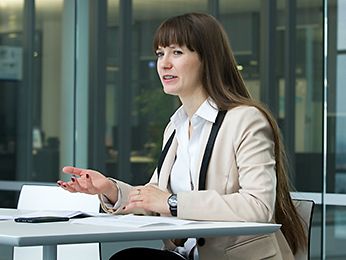Service Navigation
A conversation with Yauheniya Shynkevich – explorer of patterns
07 May 2018
A conversation with Yauheniya Shynkevich – explorer of patterns People & ideas at Deutsche Börse
Everywhere we turn change is in the air, with digital transformation affecting virtually every sector. Established companies, such as Deutsche Börse, in particular need to scrutinise their business models, think in new directions and explore new territory. In spite of all the technology involved, people remain at the centre of all development: on the one hand, new digital offerings must always follow clients’ needs, and on the other, every technological change originates in the human mind. Innovative change depends on our creativity, our initiative and our energy. In a loose series of interviews, we would like to introduce you to the people and ideas that make a substantial contribution to promoting change within Deutsche Börse.
Yauheniya Shynkevich
One of these people is Yauheniya Shynkevich from our London office. In this interview, she shares her extensive knowledge about artificial intelligence, pattern recognition and natural language processing and explains how to use these tools to create new products and services for Deutsche Börse Group.
Could you please give us some insight into your professional background?
I am a data scientist, and I’ve been working at Deutsche Börse’s Content Lab since May 2017. Before that, after obtaining a Ph.D. in computer science, I was doing consultancy work. My Ph.D. studies were interdisciplinary, touching on areas such as machine learning and computational intelligence techniques. I applied those techniques to financial data to predict future reactions of capital markets to news reports. I had to process raw news articles, so I had to use natural language processing as well. Before pursuing my Ph.D., I worked in financial software testing and development.
What are your tasks within Deutsche Börse Group?
Our team at Deutsche Börse’s Content Lab is comprised of data scientists, data engineers and use case managers. The whole team works on a number of use cases, so each data scientist is involved in several areas. My first use case involved working on predictive analytics for corporate bonds. For most securities, trading already takes place electronically, but not so for corporate bonds. Most trades are still made over-the-counter (OTC). And as Deutsche Börse Group dominates the market in settlements of European corporate bonds, we have access to very valuable data.
My aim was to analyse the historical liquidity of corporate bonds using information about their settlements and holdings at Clearstream, Deutsche Börse Group’s central securities depository. Basically, I used settlements as a proxy for trades. Based on this data as well as on publicly available information about bonds, I was able to estimate the probability of a bond being traded in the future. The question was: how probable is it that a bond will be traded tomorrow considering all the data that we have about it today? What is important is that Deutsche Börse has a lot of proprietary data that is not available to the public: data that we can analyse and use to make accurate predictions about future trading. Our goal here is to enable “smarter” trading of all types of bonds, not just corporate bonds. Besides that, we also want to promote liquidity on platforms such as Eurex Repo.
That means that by analysing historical data your model will be able to predict when corporate bonds will likely be traded?
Yes, we are trying to combine information that is available to the public with information available to Deutsche Börse only. So far, we have been happy with the predictions. Plus, we are working on further developments in bonds analytics. For example, we perform analyses of historical settlements in a particular bond and predict how likely a settlement is to be delayed. At the same time, we are looking into the possibility of recommending bonds to traders based on the activities of similar traders in the bond market.
Sounds a little bit like Amazon: people who bought these bonds might also be interested in this bond.
Exactly. We want to help people make decisions and, at the same time, suggest other trades to them that they might be interested in – bonds that they overlooked in the past but that might actually be interesting.
Could you also tell us a little bit about natural language processing techniques?
The aim of natural language processing, or NLP, is to teach a computer to understand natural language. Natural language – the way we speak and write – is very hard to analyse because it does not follow an exact logic. There are a lot of difficulties involved in understanding it.
Speech-recognition tasks are more or less solved. Recent developments in speech recognition allow us to talk to a computer, and to have the sound translated into written words. But whenever we actually try to get computers to understand the correct meaning of a sentence or to handle a meaningful conversation, that is where the complications start. This is partly because there are so many ways to say the same thing. If we say two very similar sentences but use different words, synonyms, an algorithm that only compares words will perceive them as completely different. So how can we teach the computer to understand that they are the same? Think Alexa or Siri. They talk and they listen. They are successful examples of conversational systems, also called chat bots. We are working on bringing such technologies to Deutsche Börse, and our goal is to tailor the methods to our needs. Our focus is far from a general conversation; we need a very precise system that understands what a customer needs and performs tasks accordingly.
Because of these complexities, there are still a lot of humans involved in the work process when it comes to understanding natural language. A person still needs to read the document and extract the information, or read an e-mail and classify it. Think, for example, of a person who deals with customer e-mails: he reads an email, understands its topic and either answers it or sends it to the right person. If a human has to do this, it can be monotonous and error-prone. Instead, it can be automated if we can get the computer to understand the purpose of each e-mail, generate an automated reply or forward it to the right person.
There are many use cases related to NLP here at Deutsche Börse that our group is working on at the moment. For example, a department has asked us to develop a chat bot to help operators deal with recurring client e-mails, client calls and requests so that the operators can focus on more difficult questions. We should not waste human resources on tasks that can easily be automated. That way we can be more efficient and free people to work on more challenging tasks.
You need a lot of data for everything you do. Where do you get that data?
Our priority is to leverage the rich data available in Deutsche Börse Group. The company is involved in many businesses. We support the full life cycle of a trade, and a lot of data is collected in the process. It should be used to produce new data products, to improve customer experience and to automate processes. However, there could be data issues that we should always bear in mind, such as confidentiality of client data and compliance policies. In addition, we can buy data from external providers in order to enrich internal datasets when needed. And, there are also many publicly available datasets that we can use.
Can you give us some other examples of how pattern recognition could lead to new products and services for Deutsche Börse?
Pattern recognition is concerned with trying to find hidden patterns in the data, such as non-linear dependencies. Our data science team is working on a number of use cases. For example, we analyse trading data and aim to find patterns that will help us improve liquidity. What can we do to attract more customers and to increase trading on our platforms? Our team is looking for answers to these questions using machine learning techniques, including artificial neural networks.
Another example would be our analysis of failed settlements. We are looking for patterns that help predict which securities will be hard to settle for our customers. If we can accurately predict which securities will be needed in advance, we will be able to assist our clients better and grow our revenues in the process.
Overall, the ability to recognise patterns in data depends on the availability of large datasets. For Deutsche Börse, it is extremely advantageous to use these techniques and explore opportunities for increasing revenues, cutting costs and improving products and services for our clients.
Interview: Jürgen Pfeiffer


